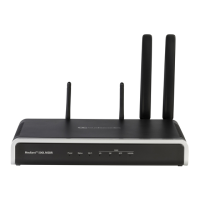User's Manual 27. Routing
Version 6.8 413 Mediant 500L MSBR
Parameter Description
If matched routing rules belong to different Forking Groups, the
device sends the call to the Forking Group of the first matched
routing rule. If the call cannot be established with any of the
destinations associated with this Forking Group and alternative
routing is enabled, the device forks the call to the Forking
Group of the next matched routing rules as long as the Forking
Group is defined with a higher number than the previous
Forking Group. For example:
Table index entries 1 and 2 are defined with Forking Group "1",
and index entries 3 and 4 with Forking Group "2": The device
first sends the call according to index entries 1 and 2, and if
unavailable and alternative routing is enabled, sends the call
according to index entries 3 and 4.
Table index entry 1 is defined with Forking Group "2", and
index entries 2, 3, and 4 with Forking Group "1": The device
sends the call according to index entry 1 only and ignores the
other index entries even if the destination is unavailable and
alternative routing is enabled. This is because the subsequent
index entries are defined with a Forking Group number that is
lower than that of index entry 1.
Table index entry 1 is defined with Forking Group "1", index
entry 2 with Forking Group "2", and index entries 3 and 4 with
Forking Group "1": The device first sends the call according to
index entries 1, 3, and 4 (all belonging to Forking Group "1"),
and if the destination is unavailable and alternative routing is
enabled, the device sends the call according to index entry 2.
Table index entry 1 is defined with Forking Group "1", index
entry 2 with Forking Group "3", index entry 3 with Forking
Group "2", and index entry 4 with Forking Group "1": The
device first sends the call according to index entries 1 and 4 (all
belonging to Forking Group "1"), and if the destination is
unavailable and alternative routing is enabled, the device
sends the call according to index entry 2 (Forking Group "3").
Even if index entry 2 is unavailable and alternative routing is
enabled, the device ignores index entry 3 because it belongs to
a Forking Group that is lower than index entry 2.
Notes:
To enable Tel-to-IP call forking, set the 'Tel2IP Call Forking
Mode' (Tel2IPCallForkingMode) parameter to Enable.
You can configure the device to immediately send the INVITE
message to the first member of the Forking Group (as in
normal operation) and then only after a user-defined interval,
send (simultaneously) the INVITE messages to the other
members. If the device receives a SIP 4xx or 5xx in response
to th
e first INVITE, it immediately sends INVITEs to all the other
members, regardless of the interval. To configure this feature,
use the ForkingDelayTimeForInvite ini file parameter.
You can implement Forking Groups when the destination is an
LDAP server or a domain name using DNS. In such scenarios,
the INVITE is sent to all the queried LDAP or resolved IP
addresses, respectively. You can also use LDAP routing rules
with standard routing rules for Forking Groups.
When the UseDifferentRTPportAfterHold parameter is enabled,
every forked call is sent with a different RTP port. Thus, ensure

